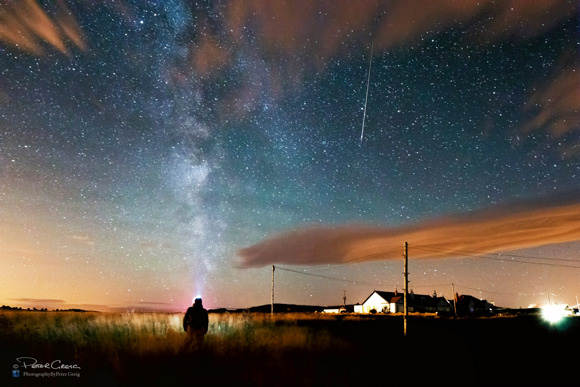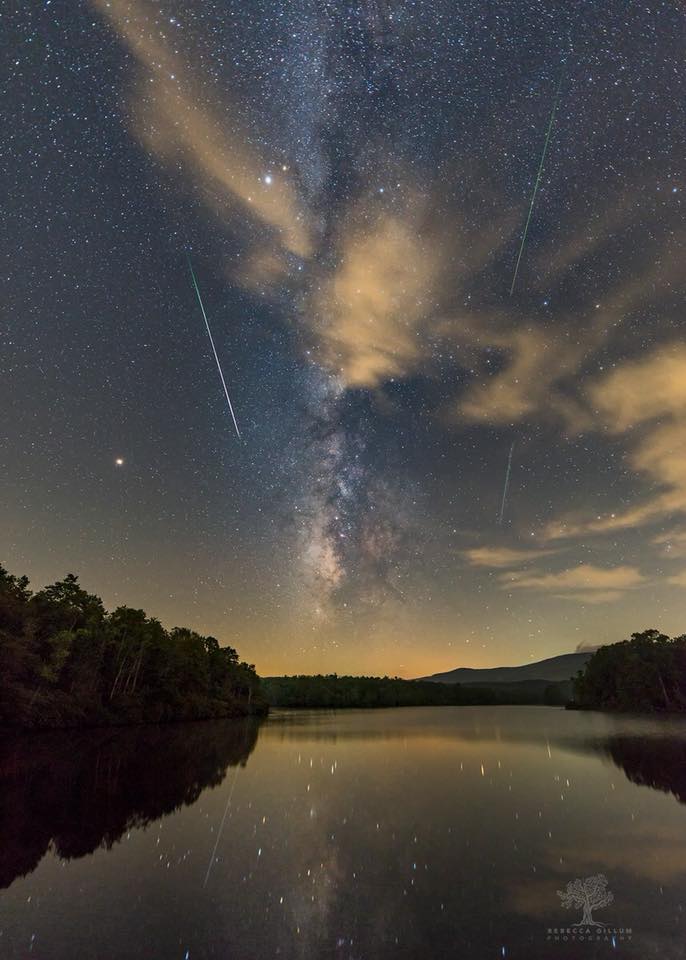EarthSky friend Eliot Herman in Tucson, Arizona caught the image at the top of this post – a bright meteor, not associated with the Perseid shower, near a bright moon – in early July, 2017.
So it’s definitely possible to see and photograph bright meteors in moonlight. And that’s good news for everyone planning to watch the 2019 Perseid meteor shower. This beloved annual shower is a much-anticipated summertime treat for us in the Northern Hemisphere. The 2019 Perseid meteor shower will likely peak before dawn August 11, 12 and 13; we anticipate the most meteors from late evening of August 12 to dawn August 13. Unfortunately, most of these peak hours will be under the light of a bright moon. The moon will be in a waxing gibbous phase, bright in the sky and drowning many meteors in its glare. What can you do in 2019 to optimize your chances for seeing Perseid meteors? We offer the 10 tips below.

1. Realize that this shower rises gradually to its peak. Few meteor showers – certainly not the Perseids – are a one-night event. The Perseid shower lasts from about July 17 to August 24 every year. That’s when our planet Earth crosses the orbital path of Comet Swift-Tuttle, the Perseid’s parent comet. What’s more, the Perseids are known to rise to their peak gradually, then fall off after the peak more rapidly. So the days leading up to the peak are a good time to watch meteors, too. You could start tonight! Expect an increasing number of meteors – and a more bothersome moon – as we get closer to 2019’s peak.
2. Be aware of the time of moonset each night. As much as possible, in the weeks between now and the peak, you’ll want to be out looking after moonset. Click here to find out when the moon sets in your sky, remembering to check the moonrise and moonset box.
3. Watch in the hours before dawn Most meteor showers are best after midnight, and the Perseids are no exception. After midnight, the part of Earth you’re standing on has turned into the meteor stream, which means the radiant point for the shower will be above your horizon. After the radiant rises, more meteors are flying … albeit, in 2019, in a increasingly moon-drenched sky. A first quarter moon sets around midnight. First quarter moon will be just four days from now, on August 7. Afterwards, the moon will be setting closer and closer to the time of dawn. The trick will be to get as close to the peak as you can, while still giving yourself a few hours with no moonlight. Use the calendar recommended above, watch moonset times carefully, and remember …
4. Avoid city lights. This should go without saying, but just a reminder. A wide open area – a field or a lonely country road – is best if you’re serious about watching meteors. Check EarthSky’s global Best Places to Stargaze map for ideas on where to go and set up.
5. Camp! Nothing beats a set-up before night begins. Of course, you’ll never see as many meteors in the evening as you will after midnight, but – if you are watching during the evening hours – you might catch an earthgrazer, which is a slow-moving and long-lasting meteor, traveling horizontally across your sky. Earthgrazers might be seen even in bright moonlight. They tend to be seen in late evening, or around midnight.

6. Make yourself comfortable. Sprawl out upon a reclining lawn chair, with an open view of sky. Bring along a blanket or sleeping bag. Your eyes can take as long as 20 minutes to adapt to the dark, so give yourself at least an hour of observation time.
7. Watch with friend or friends, and try facing in different directions so that if someone sees a meteor, that person can call out – “meteor!” – to the rest.
8. Notice the meteors’ speeds and colors, and watch for meteor trains. The Perseids are known to be colorful. The Perseids are also swift-moving, entering Earth’s atmosphere at about 35 miles per second (60 km per second). A meteor train is a persistent glow in the air, left by some meteors after they have faded from view. Trains are caused by luminous ionized matter left in the wake of this incoming space debris. A good percentage of Perseids are known to leave persistent trains. They linger for a moment or two after the meteor has gone.

9. If you’re in the Southern Hemisphere … watch! At temperate latitudes in the Southern Hemisphere, the radiant of the Perseid meteor shower never gets very high in the sky. Therefore, the number of Perseid meteors seen from this part of the world isn’t as great as at more northerly latitudes. But if you’re game, look northward in the wee hours before dawn, and you might still see a decent display of Perseids.
10. Embrace the night. We hear people bubble with excitement about seeing meteors in all sorts of conditions – moon or no moon – city lights or no city lights. The Perseids, in particular, tend to have a lot of fireballs. And so, camp out and make a night of it! At the end of the Perseid shower, look for Orion. As dawn breaks, this bright constellation will be ascending in the east before dawn. Read more.
Looking for a dark area to observe from? Check out EarthSky’s interactive, worldwide Best Places to Stargaze map.


Bottom line: With moonlight intruding on the 2019 Perseid shower, this is not the most favorable year for the Perseids. But it might be worth watching anyway. Top 10 tips for watching the shower here.
When is the next meteor shower? Click here for EarthSky’s meteor shower guide for 2019
EarthSky astronomy kits are perfect for beginners. Order today from the EarthSky store











